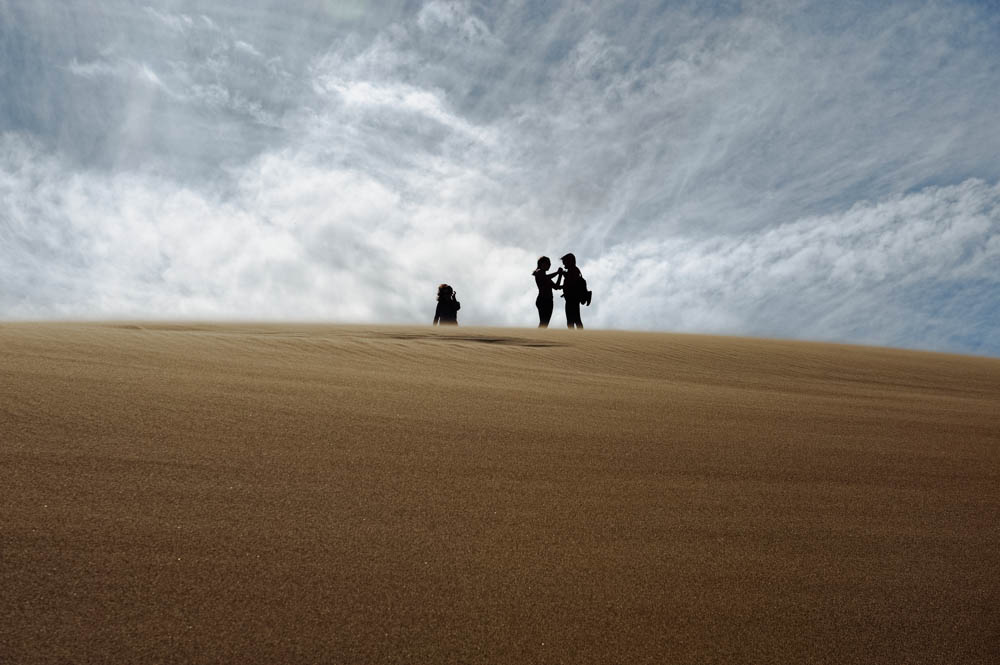Great Sand Dunes National Park and Preserve
Can you spot the sand dunes at the base of the Sangre de Cristo Mountains?
These huge dunes look totally out of place at the edge of the snow-covered Rocky Mountains. Located in south central Colorado (about 2.5 hours from Colorado Springs and nearly four hours from Denver, they lie at the foot of the Sangre de Cristo Mountains. They are the tallest sand dunes in North America.
There are no official trails into the dunes and because of the soft, ever-shifting sand, possibilities for exploration are limitless. It is permitted to walk anywhere, and one popular target is the top of the tallest dune, which conveniently is only half a mile from the edge. Still, the journey takes up to one hour and it is often a case of one step up, half a step down. It is easier to walk along sand ridges, rather than up the side of the dunes. The surface temperature of the sand can rise to over 140 F in the summer, much too hot for barefoot walking, and very hard on your dog’s paws (bring booties). Note that this is one of the rare National Parks where dogs are allowed on hiking trails. It is written everywhere that you need to keep your dog ON LEASH. I know the dunes feel like a sandbox of epic proportions, but please respect that rule so we can keep coming here with our pups (most people had their dogs off leash…).
It is often windy on the dunes (it was when we were there) and it was not a pleasant experience. Wear long pants and non-mesh shoes (or walk barefoot if the sand is cool enough), a windbreaker and buff and tight-fitting hat, as well as sunglasses if you plan to hike the dunes on a windy day. It will make your journey much more fun.
You can also rent sand board or sand sleds to play on the dunes just outside the park (regular sleds or snowboards don’t work well on dry sand). Another amazing feature of the Great Sand Dunes is Medano Creek - a small stream fed by melting snow that is only about ten miles long and flows most strongly during spring and early summer. It starts in the Sangre de Cristo mountains, runs along the east edge of the dunes and disappears below ground in the valley.
It is also a great area for stargazing and there are often ranger-led astronomy programs in the park. A really unique experience would be to camp overnight in the dunes (when weather is calm and clear to avoid blowing sand or dangerous thunderstorms with lightning). You can pitch your tent anywhere in the dune field that lies outside the day-use area. You'll have a minimum hike of 1.5 miles over the dunes, but will experience a unique overnight setting. Don’t forget that hauling your gear up slippery sand dunes is quite the workout.
There is a limit of 6 people per party, and limit of 20 parties in the dune field per night; permits are first-come, first-served (gas stoves only; no campfires). Dogs are not permitted in the dunes backcountry.
Though not inside Great Sand Dunes National Park & Preserve, Zapata Falls is a terrific little hike (0.8 miles) during a visit to the area and a fun place to cool off from the hot sun in the summer since you have to walk in the water to get there.
There are a few options for camping in the area. The Piñon Flats Campground is run by the National Park Service, with 44 sites that are first-come, first-served and 44 that visitors can reserve in advance.
For those traveling in 4WD vehicles, there are 21 campsites along Medano Pass Road within the park that are free and available on a first-come, first-served basis.
Outside the park, there is the San Luis Wilderness area, which was a state park until last year, where you can camp FOR FREE WITH 30/50 AMP power, sheltered picnic tables and fire ring in a gorgeous setting. Too good to be true? That’s what we thought, but we had a hard time leaving.





